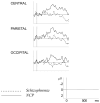Electrophysiological evidence for primary semantic memory functional organization deficits in schizophrenia
- PMID: 22460130
- PMCID: PMC4075227
- DOI: 10.1016/j.psychres.2012.02.026
Electrophysiological evidence for primary semantic memory functional organization deficits in schizophrenia
Abstract
N400, an event-related brain potential (ERP) waveform elicited by meaningful stimuli, is normally reduced by stimulus repetition (N400 repetition priming), and relatedness between the eliciting stimulus and preceding ones (relatedness priming). Schizophrenia patients' N400 relatedness priming deficits suggest impairment in using meaningful prime stimuli to facilitate processing of related concepts in semantic memory. To examine whether this deficiency arises from difficulty activating the prime concept per se, as indexed by reduced N400 repetition priming; or from impaired functional connections among concepts in semantic memory, as reflected by reduced relatedness priming but normal repetition priming; we recorded ERPs from 16 schizophrenia patients and 16 controls who viewed prime words each followed at 300- or 750-ms stimulus-onset asynchrony (SOA) by an unrelated, related or repeated target word, or a nonword, in a lexical-decision task. In both groups, N400s were largest (most negative) for unrelated, intermediate for related, and smallest for repeated targets. Schizophrenia patients exhibited subnormal N400 relatedness priming at the 300-ms SOA, but normal repetition priming at both SOAs, suggesting that their impairment in using prime words to activate related concepts results from abnormal functional connections among concepts within semantic memory, rather than inability to activate the prime concept itself.
Copyright © 2012 Elsevier Ireland Ltd. All rights reserved.
Figures









Similar articles
-
Depth-of-processing effects on semantic activation deficits in schizophrenia: an electrophysiological investigation.Schizophr Res. 2011 Dec;133(1-3):91-8. doi: 10.1016/j.schres.2011.08.002. Epub 2011 Aug 25. Schizophr Res. 2011. PMID: 21868201
-
Event-related brain potential study of semantic priming in unaffected first-degree relatives of schizophrenia patients.Schizophr Res. 2014 Mar;153(1-3):78-86. doi: 10.1016/j.schres.2014.01.001. Epub 2014 Jan 19. Schizophr Res. 2014. PMID: 24451397
-
Test-retest reliability of N400 event-related brain potential measures in a word-pair semantic priming paradigm in patients with schizophrenia.Schizophr Res. 2014 Sep;158(1-3):195-203. doi: 10.1016/j.schres.2014.06.018. Epub 2014 Jul 9. Schizophr Res. 2014. PMID: 25015029
-
N400 in schizophrenia patients.Curr Opin Psychiatry. 2013 Mar;26(2):196-207. doi: 10.1097/YCO.0b013e32835d9e56. Curr Opin Psychiatry. 2013. PMID: 23340116 Review.
-
[Schizophrenia and semantic priming effects].Encephale. 2006 Jan-Feb;32(1 Pt 1):75-82. doi: 10.1016/s0013-7006(06)76139-5. Encephale. 2006. PMID: 16633293 Review. French.
Cited by
-
Is black always the opposite of white? An investigation on the comprehension of antonyms in people with schizophrenia and in healthy participants.Behav Sci (Basel). 2015 Mar 9;5(1):93-112. doi: 10.3390/bs5010093. Behav Sci (Basel). 2015. PMID: 25760930 Free PMC article.
-
A review of recent literature employing electroencephalographic techniques to study the pathophysiology, phenomenology, and treatment response of schizophrenia.Curr Psychiatry Rep. 2013 Sep;15(9):388. doi: 10.1007/s11920-013-0388-x. Curr Psychiatry Rep. 2013. PMID: 23933976 Review.
-
Investigating thought disorder in schizophrenia: evidence for pathological activation.PLoS One. 2013 Dec 6;8(12):e82882. doi: 10.1371/journal.pone.0082882. eCollection 2013. PLoS One. 2013. PMID: 24324839 Free PMC article.
-
An incongruent reality: the N400 in relation to psychosis and recovery.Schizophr Res. 2014 Dec;160(1-3):208-15. doi: 10.1016/j.schres.2014.09.039. Epub 2014 Oct 22. Schizophr Res. 2014. PMID: 25449716 Free PMC article.
-
Abnormal neural hierarchy in processing of verbal information in patients with schizophrenia.Neuroimage Clin. 2017 Dec 27;17:1047-1060. doi: 10.1016/j.nicl.2017.12.030. eCollection 2018. Neuroimage Clin. 2017. PMID: 29349038 Free PMC article.
References
-
- Andreasen NC. Scale for the Assessment of Negative Symptoms. University of Iowa; Iowa City, Iowa: 1984a.
-
- Andreasen NC. Scale for the Assessment of Positive Symptoms. University of Iowa; Iowa City, Iowa: 1984b.
-
- Bezchlibnyk-Butler KZ, Jeffries JJ. Clinical Handbook of Psychotropic Drugs. 17th. Hogrefe & Huber; 2007.
-
- Blishen BR, Carroll WK, Moore C. The 1981 socioeconomic index for occupations in Canada. Canadian Review of Sociology and Anthropology. 1987;24:465–488.
-
- Cohen JD, Barch DM, Carter C, Servan-Schreiber D. Context-processing deficits in schizophrenia: converging evidence from three theoretically motivated cognitive tasks. Journal of Abnormal Psychology. 1999;108:120–133. - PubMed
Publication types
MeSH terms
Grants and funding
LinkOut - more resources
Full Text Sources
Medical

